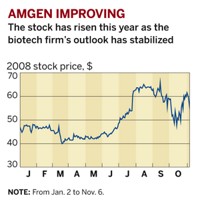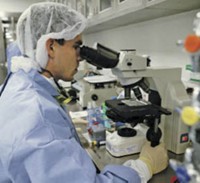Advertisement
Grab your lab coat. Let's get started
Welcome!
Welcome!
Create an account below to get 6 C&EN articles per month, receive newsletters and more - all free.
It seems this is your first time logging in online. Please enter the following information to continue.
As an ACS member you automatically get access to this site. All we need is few more details to create your reading experience.
Not you? Sign in with a different account.
Not you? Sign in with a different account.
ERROR 1
ERROR 1
ERROR 2
ERROR 2
ERROR 2
ERROR 2
ERROR 2
Password and Confirm password must match.
If you have an ACS member number, please enter it here so we can link this account to your membership. (optional)
ERROR 2
ACS values your privacy. By submitting your information, you are gaining access to C&EN and subscribing to our weekly newsletter. We use the information you provide to make your reading experience better, and we will never sell your data to third party members.
Business
Biotech Companies Maintain Stride
Larger companies continue to feel the pressure to bring new drugs to market
by Lisa M. Jarvis
August 24, 2006
| A version of this story appeared in
Volume 84, Issue 34
Biotechnology companies maintained a steady pace in the second quarter, recording healthy growth in revenues and earnings despite a marked absence of new drug launches from the larger companies.
On average, revenues for the 20 biotech companies tracked by C&EN were up 21.5%, while earnings increased 27.9%. Combined profit margin was 24.9%, compared with 23.7% in the second quarter of 2005. For the first half of the year, earnings increased 36.9%, based on a 22.3% rise in revenues.
Amgen posted an 11.8% increase in earnings to $1.24 billion, based on a 13.6% rise in revenues to $3.60 billion. Although Amgen has a relatively robust late-stage pipeline that should help buttress its business in the future, the company currently relies on product label expansions and price increases for growth.
The firm's sales of the anemia drug Aranesp increased a healthy 26% in the quarter to $1.1 billion, while combined sales of Neulasta and Neupogen, both for treating chemotherapy-induced neutropenia (a blood disorder), rose 12% to $1.0 billion. U.S. sales of the rheumatoid arthritis treatment Enbrel were up 13% in the quarter, an improvement driven in part by a 4.9% price increase enacted in May.
After stabilizing in the first quarter of the year, sales of the anemia drug Epogen again faltered in the second quarter. Sales were off 5% to $613 million, a decline Amgen attributes to inventory changes and the continued switch to using Aranesp in hospitals. The company says a 1% price increase was implemented at the end of the quarter.
Genentech saw an 83.0% leap in earnings to $602 million, on a 44.0% increase in revenues to $2.20 billion. The improvement was led by strong sales of the company's cancer franchise, with even older products continuing to enjoy robust growth on mounting evidence of their effectiveness.
Herceptin continues to see a swell in sales, based on data released last year that show the antibody can significantly cut the risk of recurrence of early-stage breast cancer. Sales more than doubled in the quarter to $320 million, a major leap considering Herceptin was launched in 1998.
Sales of Avastin, which hit the market in 2004, soared 72% to $423 million. Though the Avastin numbers appear strong, they came in behind analysts' forecasts, which were based on expectations of increased use of the drug in lung and breast cancers ahead of approval in those indications. The drug is currently approved to treat colon cancer and is expected to gain Food & Drug Administration approval to treat lung cancer in the fourth quarter.
Genentech's Lucentis, a treatment for age-related macular degeneration launched on the last day of the quarter, brought in $10 million in sales, quelling analyst fears that the drug would not take off. Lucentis is an antibody fragment related to Avastin, and physicians had started to use Avastin to treat the eye disease prior to the approval of Lucentis.
Morgan Stanley analyst Steven Harr says it is too early to speculate on the demand trends, but he wrote to clients, "We expect a strong launch and continue to see the threat of off-label Avastin as overstated."
Genentech's share of U.S. sales of Rituxan, which it comarkets in the U.S. with Biogen Idec, was up 17% to $526 million. Genentech announced in its second-quarter results that it would advance ocrelizumab, a follow-on to Rituxan, to Phase III clinical trials.
The commercialization of ocrelizumab, expected in 2009, would alter the profit-sharing arrangement between Genentech and Biogen Idec for Rituxan and other CD20 inhibitors. According to Harr, the launch of a second-generation CD20 inhibitor would decrease Biogen Idec's portion of the profits from all CD20 drugs by as much as 25%.
Yet the success of Rituxan is critical for Biogen Idec, which relied solely on Rituxan and the multiple sclerosis drug Avonex for sales in the quarter. Biogen Idec reported $206 million in Rituxan sales, while Avonex sales were $429 million, up 12%. Earnings were up 32.4% to $197 million.
On the positive side, Biogen Idec was given the green light in the second quarter by both U.S. and European regulatory agencies to relaunch Tysabri, the multiple sclerosis drug that had been pulled from the market after being linked to several patient deaths.
As the big biotechs struggle to keep their product portfolios fresh, several small and medium-sized companies are enjoying strong growth on new product launches.
Gilead Sciences saw a 38.4% surge in revenues to $685 million, based on healthy growth of its HIV franchise. Though sales are falling for Viread and Emtriva, two older HIV drugs, the loss is being more than offset by Truvada, the fixed-dose combination of the two older treatments.
Celgene enjoyed a 35.4% rise in revenues to $197 million and a 38.5% earnings increase to $43 million. Revlimid, approved in late 2005, brought in $63 million in sales, while Thalomid sales increased 14% to $107 million.
Revenues at Amylin totaled $118 million in the second quarter, compared with $46.8 million in the prior year's period, driven by the success of the diabetes treatment Byetta.
Table: Biotechnology Companies
Genentech continues to be the gold standard among the big biotechs.
Table is available as an image file.




Join the conversation
Contact the reporter
Submit a Letter to the Editor for publication
Engage with us on Twitter